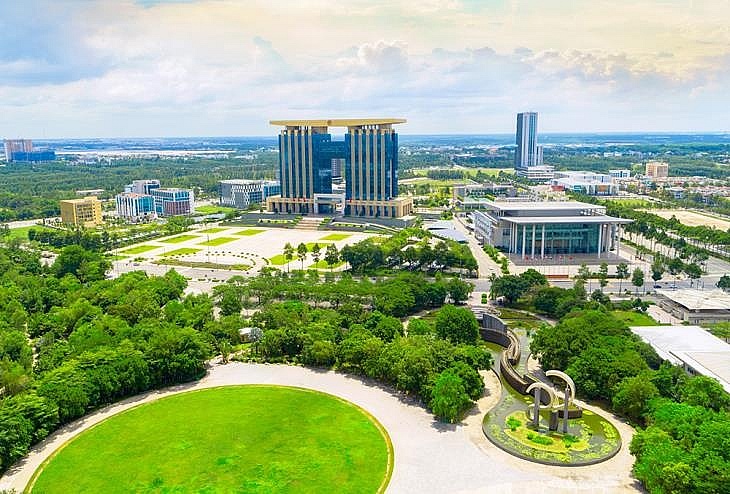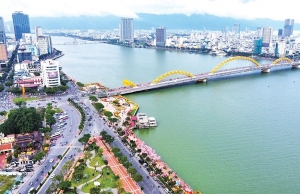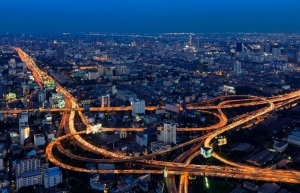The blueprint for smart city
Ahead in the race currently is Binh Duong province. At the end of last year, the World Intelligent Community Forum honoured Binh Duong as one of 21 communities with an outstanding smart city development strategy for the third year in a row. Mai Hung Dung, Standing Vice Chairman of Binh Duong People’s Committee, said that its infrastructure system is heavily invested in, while the innovation ecosystem is constantly developing.
“Since 2016, Binh Duong has achieved positive results, the economy continues to grow, the economic structure continues to shift in the right direction, GDP per capita increases, and the urbanisation rate has reached 82 per cent,” Dung said. “Those are a solid foundation for Binh Duong to build a smart city, with a strong focus on balancing economic development with social progress and green growth.”
Binh Duong’s smart city project for this decade covers people, technology, business, and foundational elements, but these pillars can and will be adjusted to be consistent with the current situation and the key challenges ahead.
 |
| Binh Duong Smart City, source: binhduong.gov.vn |
Meanwhile, Danang is the first city chosen by IBM as one of 33 cities worldwide to receive sponsorship from the IBM Smarter Cities Challenge competition.
IBM’s three-year, $50 million initiative involves the direct participation of experts from IBM, who research and make detailed recommendations to help solve important urban problems in each locality. It focuses on using smart central operating solutions to ensure water quality, provide the best public transportation, and minimise traffic congestion.
In its smart city building plan towards 2030, Ho Chi Minh City is looking at a smart urban operations centre, shared data warehouse, open data ecosystem development, a centre for socioeconomic simulation and forecasting, and a centre for information security.
In particular, its smart city operation centre started phase 1 in 2019. Phase 2 for 2021-2025 is focused on smart solutions in a range of sectors in specific fields, and phase 3 after 2025 will aim towards strengthening technology foundations as well as restoring capacity and security.
Hanoi has also taken specific steps to implement different aspects of smart cities. At the Vietnam-Asia Smart City Summit in November, Tran Sy Thanh, Chairman of Hanoi People’s Committee said, “The sustainable smart city model that Hanoi aims will bring a truly quality, convenient, safe, and friendly living environment for all. At the same time, it will help build a local government system for the development of both organisations and businesses.”
The most important issue of digital transformation is building databases, according to Thanh. “Data must be accurate, complete, and transparent, and use the shortest time and cost,” Thanh said.
According to Matthew Powell, director of Savills Hanoi, at the city level, many local governments have been making efforts to build smarter cities such as improving the efficiency of electricity use, water, and social utility infrastructure.
“At the project and building level, investors and buyers are aiming to smarten management and operations, from security systems, to internet connections, from electricity usage to other factors to minimise impact on the environment,” Powell said. “At the apartment level, products have gradually appeared on the market that are integrated with smart support systems and synchronously connected to the internet provided by third parties.”
At the micro level, many real estate businesses also promote the development of smart urban projects for their real estate projects.
A typical example is North Hanoi Smart City in Dong Anh district of Hanoi, funded by a joint venture between BRG Group and Japanese-led Sumitomo Corporation. With a total investment of $4.2 billion, this project is expected to be a premise and driving force for urban development in Dong Anh district in Hanoi, and the area north of the Red River in general.
To be operational by 2032, the project will apply Industry 4.0 towards a sustainable city model, driven by green living style and modern technology application, highlighted by the application of new-generation smart services system.
Vietnam’s largest private enterprise, Vingroup, is also developing an urban area called Vinhomes Smart City. With an area of 280 hectares, Vinhomes Smart City has learned and organised application operations according to smart urban models in the world such as Singapore, Songdo of South Korea, and Fujisawa of Japan.
 | Danang the jewel in central region crown Danang has long been known as an alluring place to live in Vietnam. However, for its long-term vision, the city targets to become a liveable city at the international level. |
 | Thailand steps up smart city development Thailand is accelerating the development of smart cities, aiming to enhance the country's digital capabilities and the quality of life for urban communities towards a sustainable future, said Thai Deputy Prime Minister and Minister of Commerce Phumtham Wechayachai. |
 | Smart city creation must be robust and appropriate Smart city development in Vietnam can be used as a tool in economic progress to help it become a high-income country. |
What the stars mean:
★ Poor ★ ★ Promising ★★★ Good ★★★★ Very good ★★★★★ Exceptional
Related Contents
Latest News
More News
- Sun Group breaks ground on $2 billion Van Don casino complex (December 19, 2025 | 18:14)
- Rare, beautiful, sustainable: the mark of iconic real estate (December 19, 2025 | 08:00)
- Owner-occupied housing stabilises, paving the way for new growth cycle (December 18, 2025 | 17:04)
- Unlocking urban potential of smart cities (December 18, 2025 | 16:50)
- Green finance offers 'passport' for Vietnamese construction, building materials firms (December 15, 2025 | 08:00)
- Gamuda Land commit long-term investment (December 12, 2025 | 11:49)
- HITC ties up with Evolution to develop AI and hyperscale data centres in Vietnam (December 11, 2025 | 12:09)
- Real estate deals boom via high-profile names (December 08, 2025 | 11:32)
- Industrial segment shaped by M&As (December 08, 2025 | 08:00)
- The Privé sets the benchmark for luxury real estate (December 05, 2025 | 08:28)

 Tag:
Tag:




















 Mobile Version
Mobile Version